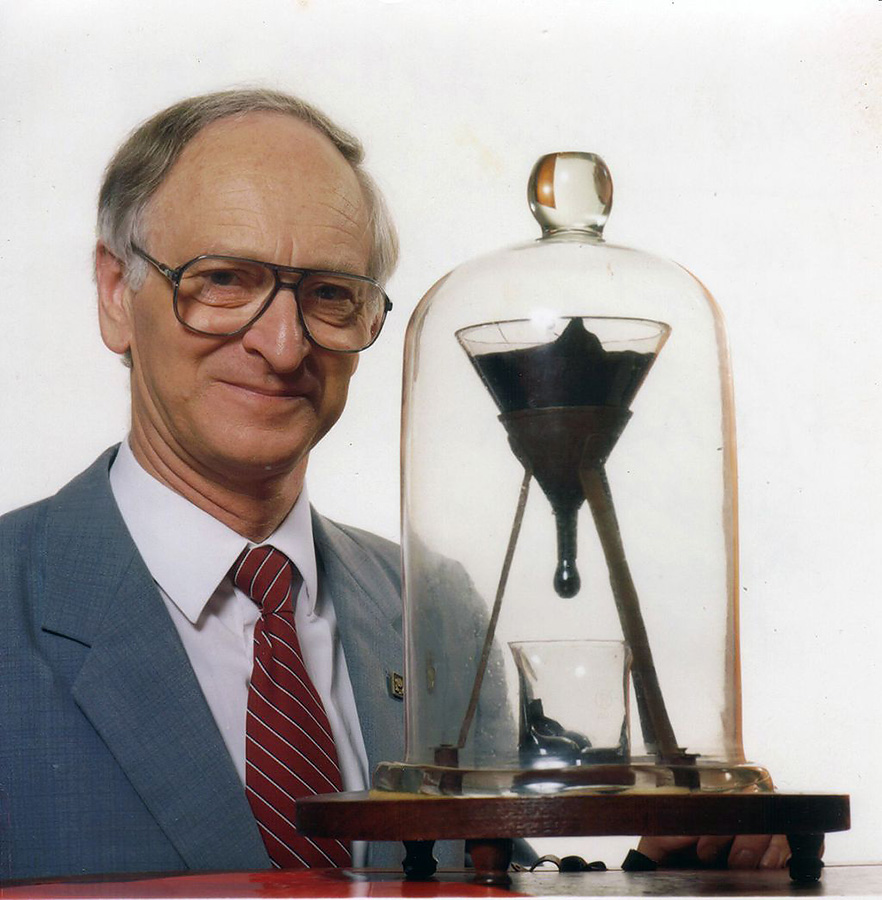
Long
When I heard the world’s longest experiment was just down the road from my house, and it was free, I had to take a look. Located in the physics building at the University of Queensland, the experiment is one of Australia’s lesser known quirks. This surprised me, given it’s been running continuously for 92 years.
It all started back in 1927, when professor Thomas Parnell was keen to show that pitch (commonly known as bitumen) is both solid and liquid. At room temperature you can shatter pitch with a hammer it’s that brittle. However, at the same temperature, Parnell proved, pitch is also viscous and actually drops like liquid. The catch is, it takes a while to do so – roughly ten years on average!

Slow
To prove his theory, Parnell poured some hot pitch into a glass funnel with a sealed stem and let it settle for three years. The stem was then cut in 1930 and it’s been dropping – albeit very slowly – ever since. Unfortunately, as it often dropped unexpectedly on weekends, Parnell didn’t see it fall in his lifetime.
Ill-timed
Neither did the second custodian, John Mainstone, who oversaw the experiment for 52 years! Allegedly Mainstone eyeballed the experiment for an entire weekend in 1977, missed the drop by one day and went home dog-tired and disheartened. Then, in 1988, the pitch alluded him yet again while he was making a cup of tea and once more in 2000 when a storm caused a webcam to malfunction. He died of a heart attack just months before the painstakingly slow pitch drop was first witnessed.

The baton was then passed to Professor Andrew White and under his custodianship the event was finally validated during ‘the 9th drop’ in April 2014, when 483 people saw it on a live webcam. Eighty seven years after its inception! Hooley Dooley! Pitch is now thought to be the world’s thickest fluid, as it’s approximately 230 billion times more viscous than water.
I relayed the information to my eight-year-old son, who remarked, “why is the experiment still going if they’ve already proved it drops daddy?” A fair point, I thought, but then of course the pitch drop wouldn’t hold the Guinness World Record for the ‘longest running laboratory experiment’ otherwise.

Short
My visit was fleeting, but fun. On a brilliant winter’s day I caught a bus to The Great Court, where the physics building is located in Queensland University’s St Lucia campus. However, before I reached the sluggishly quirky pitch drop, I stumbled across a historic titbit tucked away in the court.

Every year since 1985 a race has been held around The Great Court (aptly named The Great Court Race) in the tradition of the event held at Cambridge and depicted in the film Chariots of Fire. The race has produced some Australian Olympians in the past, although one thing I noticed – the runner’s times appear to be getting slower.
Following this, I wandered into the physics building and stared at the steely goop, hoping – on the very odd chance – I might be one of the sacred few to witness a drop (of course I didn’t). I then made my way across the apple-green sward of The Great Court and stuck my head into UQ’s Anthropology Museum, which allegedly houses Australia’s largest collection of ethnographic material.

So is the pitch drop experiment worth visiting?
Given that UQ’s St Lucia campus is so pretty, yes, it’s worth a trip to see the pitch in inaction, even if it’s also quite possibly the world’s most boring experiment. If you’ve got the patience, you can tune into the tenth drop, which is estimated to take another 14 years or so.
A parting thought
Dr White has this to say about the pitch drop: “it gives you a connection to deep time that you don’t get in your normal lifetime”.